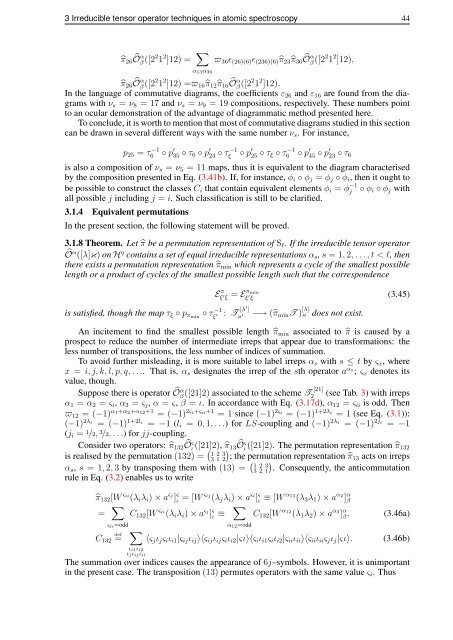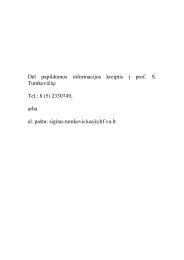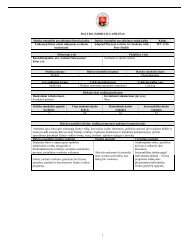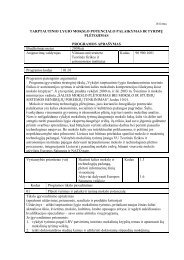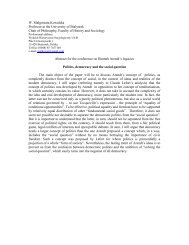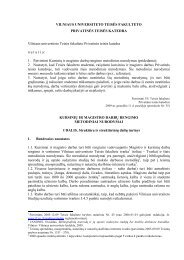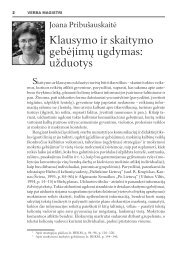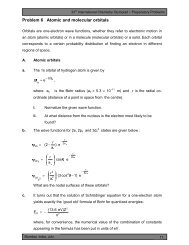Algebraic development of many-body perturbation theory in ...
Algebraic development of many-body perturbation theory in ...
Algebraic development of many-body perturbation theory in ...
- No tags were found...
You also want an ePaper? Increase the reach of your titles
YUMPU automatically turns print PDFs into web optimized ePapers that Google loves.
3 Irreducible tensor operator techniques <strong>in</strong> atomic spectroscopy 44̂π 26 Ô α β ([2 2 1 2 ]12) = ∑α 13 α 36ϖ 36 ɛ (26)(6) ɛ (236)(6)̂π 23̂π 36 Ô α β ([2 2 1 2 ]12),̂π 26 Ô α β ([2 2 1 2 ]12) =ϖ 16̂π 12̂π 16 Ô α β ([2 2 1 2 ]12).In the language <strong>of</strong> commutative diagrams, the coefficients ε 26 and ε 16 are found from the diagramswith ν s = ν 8 = 17 and ν s = ν 9 = 19 compositions, respectively. These numbers po<strong>in</strong>tto an ocular demonstration <strong>of</strong> the advantage <strong>of</strong> diagrammatic method presented here.To conclude, it is worth to mention that most <strong>of</strong> commutative diagrams studied <strong>in</strong> this sectioncan be drawn <strong>in</strong> several different ways with the same number ν s . For <strong>in</strong>stance,p 25 = τ6 −1 ◦ p ′ 35 ◦ τ 6 ◦ p ′ 24 ◦ τ −1ξ◦ p ′ 25 ◦ τ ξ ◦ τ6 −1 ◦ p ′ 45 ◦ p ′ 23 ◦ τ 6is also a composition <strong>of</strong> ν s = ν 5 = 11 maps, thus it is equivalent to the diagram characterisedby the composition presented <strong>in</strong> Eq. (3.41b). If, for <strong>in</strong>stance, φ i ◦ φ j = φ j ◦ φ i , then it ought tobe possible to construct the classes C i that conta<strong>in</strong> equivalent elements φ i = φ −1j ◦ φ i ◦ φ j withall possible j <strong>in</strong>clud<strong>in</strong>g j = i. Such classification is still to be clarified.3.1.4 Equivalent permutationsIn the present section, the follow<strong>in</strong>g statement will be proved.3.1.8 Theorem. Let ̂π be a permutation representation <strong>of</strong> S l . If the irreducible tensor operatorÔ α ([λ]κ) on H q conta<strong>in</strong>s a set <strong>of</strong> equal irreducible representations α s , s = 1, 2, . . . , t < l, thenthere exists a permutation representation ̂π m<strong>in</strong> which represents a cycle <strong>of</strong> the smallest possiblelength or a product <strong>of</strong> cycles <strong>of</strong> the smallest possible length such that the correspondenceE π ξ ′ ξ = E π m<strong>in</strong>ξ ′ ξ(3.45)is satisfied, though the map τ ξ ◦ p πm<strong>in</strong> ◦ τ −1ξ: T [λ′ ]′ κ−→ (̂π ′m<strong>in</strong> T ) [λ]κ does not exist.An <strong>in</strong>citement to f<strong>in</strong>d the smallest possible length ̂π m<strong>in</strong> associated to ̂π is caused by aprospect to reduce the number <strong>of</strong> <strong>in</strong>termediate irreps that appear due to transformations: theless number <strong>of</strong> transpositions, the less number <strong>of</strong> <strong>in</strong>dices <strong>of</strong> summation.To avoid further mislead<strong>in</strong>g, it is more suitable to label irreps α s with s ≤ t by ς x , wherex = i, j, k, l, p, q, . . .. That is, α s designates the irrep <strong>of</strong> the sth operator a αs ; ς x denotes itsvalue, though.Suppose there is operator Ôα [21]([21]2) associated to the scheme T 2 (see Tab. 3) with irrepsα 1 = α 2 = ς i , α 3 = ς j , α = ς, β = ι. In accordance with Eq. (3.17d), α 12 = ς ii is odd. Thenϖ 12 = (−1) α 1+α 2 +α 12 +1 = (−1) 2ς i+ς ii +1 = 1 s<strong>in</strong>ce (−1) 2ς i= (−1) 1+2λ i= 1 (see Eq. (3.1)):(−1) 2λ i= (−1) 1+2l i= −1 (l i = 0, 1, . . .) for LS-coupl<strong>in</strong>g and (−1) 2λ i= (−1) 2j i= −1(j i = 1 /2, 3 /2, . . .) for jj-coupl<strong>in</strong>g.Consider two operators: ̂π 132 Ôι ς ([21]2), ̂π 13 Ôι ς ([21]2). The permutation representation ̂π 132is realised by the permutation (132) = ( 1 2 33 1 2); the permutation representation ̂π13 acts on irrepsα s , s = 1, 2, 3 by transpos<strong>in</strong>g them with (13) = ( 1 2 33 2 1). Consequently, the anticommutationrule <strong>in</strong> Eq. (3.2) enables us to writêπ 132 [W ς ii(λ i λ i ) × a ς j] ς ι = [W ς ij(λ j λ i ) × a ς i] ς ι ≡ [W α 13(λ 3 λ 1 ) × a α 2] α β= ∑C 132 [W ς ii(λ i λ i ) × a ς j] ς ι ≡∑C 132 [W α 12(λ 1 λ 2 ) × a α 3] α β,ς ii =oddα 12 =odd(3.46a)defC 132 = ∑ 〈ς j ι j ς i ι i1 |ς ij ι ij 〉〈ς ij ι ij ς i ι i2 |ςι〉〈ς i ι i1 ς i ι i2 |ς ii ι ii 〉〈ς ii ι ii ς j ι j |ςι〉. (3.46b)ι i1 ι i2ι j ι ij ι iiThe summation over <strong>in</strong>dices causes the appearance <strong>of</strong> 6j–symbols. However, it is unimportant<strong>in</strong> the present case. The transposition (13) permutes operators with the same value ς i . Thus


